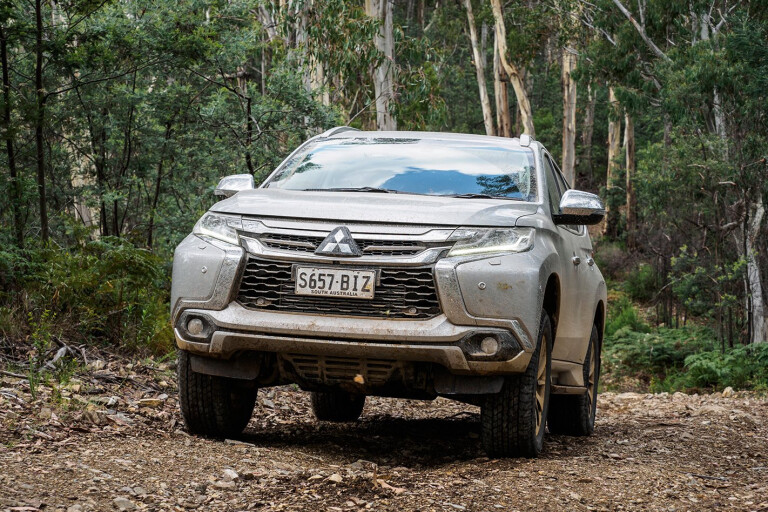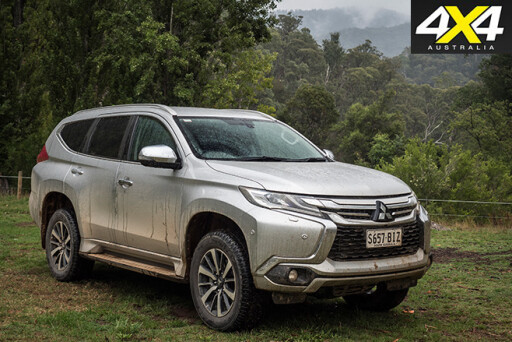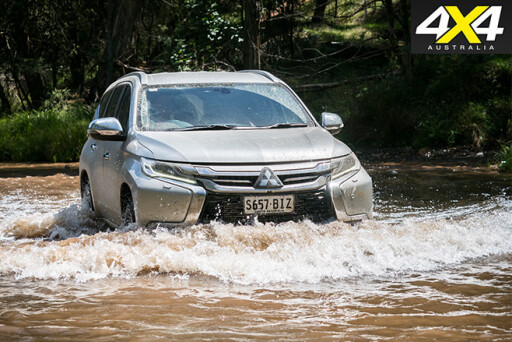
Mid-range Pajero Sport GLS has plenty of bang for its buck!
WHAT’S THE DEAL?
DESPITE the name, the Pajero Sport has nothing to do with the Pajero. It’s more closely related to the Triton ute, sharing much of its underbody structure, some panels and its 2.4-litre engine. The Pajero Sport is the replacement for the Challenger.
There are three models in the range, starting with the GLX priced from $45,000. For that coin you get an auto transmission, LED headlights, smart key entry and start, reversing camera, rear parking sensors, digital radio and 18-inch alloy wheels. It’s a decent spread, undercutting many ute-based rivals. The five-year warranty seals a good value deal.
The GLS we tested here is $48,500 and brings a rear diff lock, leather seats, dual-zone ventilation and auto wipers and headlights. It’s arguably the pick of the bunch, especially at this price.
 At the top of the range is the Exceed, which is a $52,750 proposition. It adds a better sound system and a DVD player for the rear, as well as various active safety features including blind spot warning and auto braking.
At the top of the range is the Exceed, which is a $52,750 proposition. It adds a better sound system and a DVD player for the rear, as well as various active safety features including blind spot warning and auto braking.
PRACTICALITY
FROM the second you step into it there’s a feeling the Pajero Sport isn’t particularly big, and it’s certainly not as spacious as the Prado.
The front seats are quite high and the roof line above the windscreen is low. Plus, the cabin isn’t especially wide, so three across the back will be a squeeze.
Speaking of back seats, the Pajero Sport misses out on third-row seats common in this segment. The third row is available overseas, but because side curtain airbags don’t stretch all the way it was decided not to bring it to Australia.
That said, the lack of a third row of seats means luggage space isn’t bad. As a car for two people (or even a small family) looking to do a big trip, it’s a sensible size.
 Even the second row of seats has compromises. There are no air vents, for example, and the child seat anchor points are in the roof at the back of the car, so anyone looking to travel with kids will have child seat straps feeding through the luggage area. The middle seatbelt also retracts out of the roof.
Even the second row of seats has compromises. There are no air vents, for example, and the child seat anchor points are in the roof at the back of the car, so anyone looking to travel with kids will have child seat straps feeding through the luggage area. The middle seatbelt also retracts out of the roof.
Up front, storage space is minimal. There’s a pair of cupholders, some door pockets and a covered binnacle. The only additional storage is a slim pen or coin holder on either side of the main centre console. Our experience with off-roading suggests a few more hidey-holes would be useful.
ON THE ROAD
AT 2.4 litres the Pajero Sport’s engine is towards the smaller end of the scale for its class. But it still manages decent figures, with a fairly useful 430Nm peak.
But it’s the eight-speed auto that transforms its performance, compared with the Triton. There are plenty of ratios to choose from and the gearing is fairly short – for example, accelerate hard and it drops into fourth gear by 85km/h.
Fortunately the shifts are smooth and well timed, so as the transmission goes about making the most out of the engine, you can go about enjoying respectable performance.
 Fuel economy is also a winner. The official claim is 8.0L/100km and, while we got close to that with some gentle suburban cruising mixed with some interurban freeways, on our four-wheel drive route it used a conservative 10.8L/100km.
Fuel economy is also a winner. The official claim is 8.0L/100km and, while we got close to that with some gentle suburban cruising mixed with some interurban freeways, on our four-wheel drive route it used a conservative 10.8L/100km.
It’s lucky it doesn’t use much fuel because it has a very modest tank. At 68 litres you’ll limit your usable range to about 500km – less if you’re towing or going off-road.
Speaking of which, the Pajero Sport trumps key rivals by 100kg on claimed tow capacity, at 3100kg.
Through bends the steering is pretty awful, with an overly light feel that does little to inspire confidence on country roads. The soft suspension also translates to some leaning if you tip in hard.
That suspension at least does a good job of soaking up bumps, especially big ones. It’s a car that somehow revels in a large washout or speed hump, albeit not as convincing on smaller imperfections.
OFF-ROAD
BEING based on the Triton, there’s a proven – read: ageing – ladder frame chassis that delivers on ruggedness. There’s also good ground clearance and some protection underneath.
The 218mm of clearance teams with good articulation to make for relatively easy progress.
Up front the approach angle is good, and there are small plastic spats that act as an early warning. While the rear only improves on the Triton’s departure angle by about one degree, the result is more convincing. It’s far less prone to dragging its tail, and if you are going to hit it’ll likely grab the spare tyre or exhaust tip before damaging anything substantial.
 The Pajero Sport’s biggest asset is its Super Select II four-wheel drive system. With a centre diff it allows the car to be driven on bitumen with all four wheels driving, which is handy on greasy roads or when regularly transitioning from gravel to bitumen.
The Pajero Sport’s biggest asset is its Super Select II four-wheel drive system. With a centre diff it allows the car to be driven on bitumen with all four wheels driving, which is handy on greasy roads or when regularly transitioning from gravel to bitumen.
The traction control occasionally needs encouragement in the form of extra throttle to direct drive to a wheel that’s not spinning, but it soon works it out and maintains progress. There’s also a centre diff lock and, in the GLS, a rear diff lock, ensuring better traction if you know you’re headed somewhere that needs it.
VERDICT
AS a two-person tourer, the Pajero Sport is a winner: good size, rugged design and great off-road credentials. The drivetrain is also impressive, especially the way it doesn’t use much fuel.
However, as a family car it’s less convincing. The child seat and middle rear seatbelt set-up is sub-standard, and the compact space is quickly eaten up by bodies and luggage.
PRICE AND SPECIFICATIONS
Price: $48,500
Engine: 2.4-litre 4-cylinder turbo-diesel
Power: 133kW at 3500rpm
Torque: 430Nm at 2500rpm
Transmission: 8-speed auto
4WD system: part-time dual-range
Braked tow capacity: 3100kg
Spare tyre: full size
Fuel tank: 68 litres
Fuel use (claimed): 8.0L/100km
Fuel use on test: 10.8L/100km
Approach angle: 30.0deg
Departure angle: 23.1deg
Ground clearance: 218mm

COMMENTS